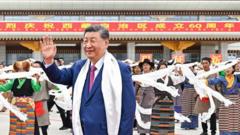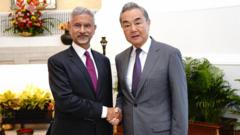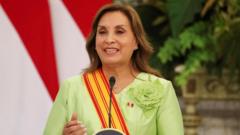This article examines the dual narratives of Xi Jinping's visit to Tibet, focusing on his push for unity and development, while contrasting it with the Tibetan yearning for autonomy and recognition of human rights.
**Xi Jinping's Historic Visit to Tibet: Unity and Development Addressed Amidst Tensions**

**Xi Jinping's Historic Visit to Tibet: Unity and Development Addressed Amidst Tensions**
Xi Jinping emphasizes stability and growth during a significant visit to the politically sensitive Tibetan region, while navigating historical complexities.
In an unexpected move, Chinese President Xi Jinping visited Tibet to commemorate the 60th anniversary of the establishment of the Tibet Autonomous Region. Speaking to a crowd of approximately 20,000 in Lhasa, Xi underscored a message of unity and development, particularly in light of the ongoing disconnect between the central government and Tibetan cultural identity. This visit marks only his second as president to the region, symbolizing a strong political show of authority over Tibet, which has seen a history of resistance against Beijing's governance.
During his address, Xi credited the local government for its efforts in "combatting separatism," a direct reference to longstanding calls for Tibetan independence. Importantly, he refrained from mentioning the Dalai Lama—Tibet's exiled spiritual leader who advocates for genuine autonomy within China. This silence from Xi may reveal the Chinese Communist Party's sensitive relationship with the figure, who Beijing labels a separatist, particularly following the Dalai Lama's recent announcement that only his office will choose a successor.
Xi articulated a vision for Tibet predicated on political stability, social order, ethnic unity, and congruity with religious practices. State media framed the visit as a demonstration of revitalization in the region, highlighting Xi's engagement with cultural events and local officials. Critics, however, remain skeptical of the narrative—the region has faced accusations of human rights violations, including suppression of religious practices. Some Tibetan monks have voiced concerns over their diminishing freedoms under CCP policies.
In a counter-narrative, Chinese officials assert that the Tibetan populace's living standards have improved dramatically under their governance, a claim met with mixed reactions. The CCP's policies have led to mandating education in state-run schools, reinforcing Mandarin over the Tibetan language, which many see as a direct threat to cultural identity.
Xi's visit came alongside the announcement of an ambitious infrastructure project—a massive dam on the Yarlung Tsangpo river, aiming to expand energy production but raising fears of ecological disruption and geopolitical tensions with neighboring countries, particularly India. This juxtaposition—between development and the region's cultural integrity—invites deeper scrutiny of Beijing's long-term intentions for Tibet.
Ultimately, Xi’s visit symbolizes a concerted effort to enforce Beijing's narrative of progress while navigating the treacherous waters of historical and cultural grievances, demonstrating that the path to stability remains fraught with challenges amid the aspirations of the Tibetan people for recognition and rights.
During his address, Xi credited the local government for its efforts in "combatting separatism," a direct reference to longstanding calls for Tibetan independence. Importantly, he refrained from mentioning the Dalai Lama—Tibet's exiled spiritual leader who advocates for genuine autonomy within China. This silence from Xi may reveal the Chinese Communist Party's sensitive relationship with the figure, who Beijing labels a separatist, particularly following the Dalai Lama's recent announcement that only his office will choose a successor.
Xi articulated a vision for Tibet predicated on political stability, social order, ethnic unity, and congruity with religious practices. State media framed the visit as a demonstration of revitalization in the region, highlighting Xi's engagement with cultural events and local officials. Critics, however, remain skeptical of the narrative—the region has faced accusations of human rights violations, including suppression of religious practices. Some Tibetan monks have voiced concerns over their diminishing freedoms under CCP policies.
In a counter-narrative, Chinese officials assert that the Tibetan populace's living standards have improved dramatically under their governance, a claim met with mixed reactions. The CCP's policies have led to mandating education in state-run schools, reinforcing Mandarin over the Tibetan language, which many see as a direct threat to cultural identity.
Xi's visit came alongside the announcement of an ambitious infrastructure project—a massive dam on the Yarlung Tsangpo river, aiming to expand energy production but raising fears of ecological disruption and geopolitical tensions with neighboring countries, particularly India. This juxtaposition—between development and the region's cultural integrity—invites deeper scrutiny of Beijing's long-term intentions for Tibet.
Ultimately, Xi’s visit symbolizes a concerted effort to enforce Beijing's narrative of progress while navigating the treacherous waters of historical and cultural grievances, demonstrating that the path to stability remains fraught with challenges amid the aspirations of the Tibetan people for recognition and rights.
















